The Best Trail Running Shoes of 2024 (So Far)
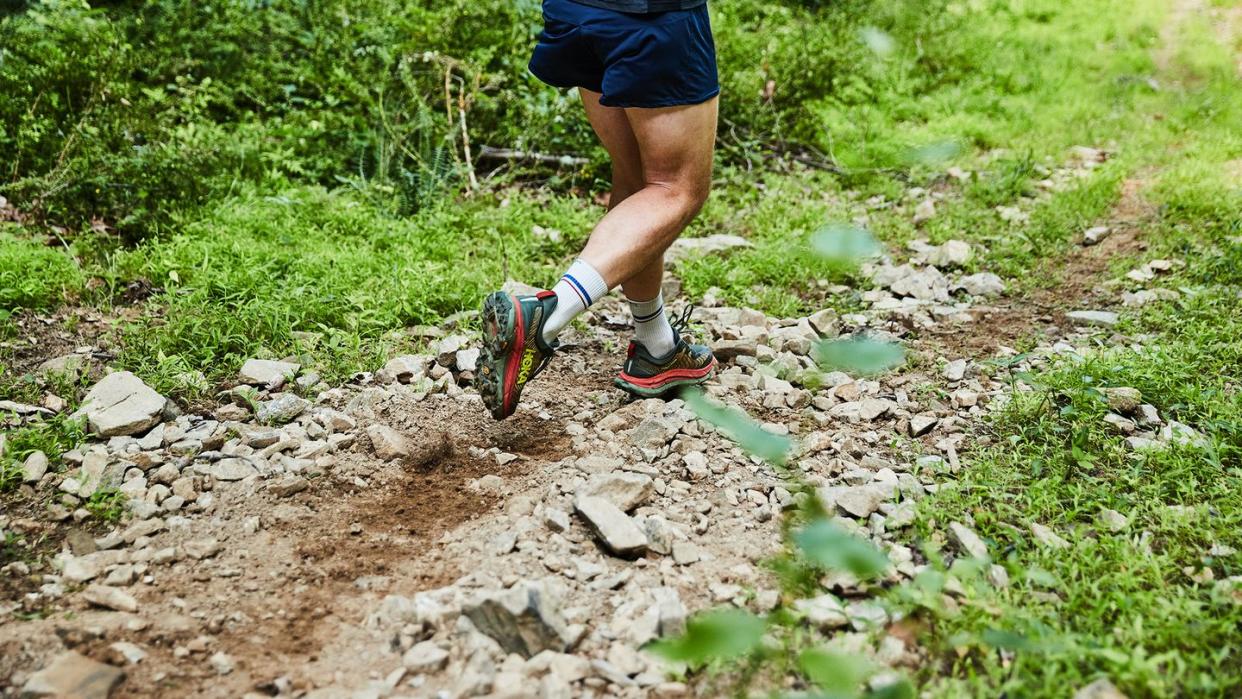
"Hearst Magazines and Yahoo may earn commission or revenue on some items through these links."
Editor’s Note: We reviewed our shoe selections on March 22, and have updated our recommendations. The below models now include the top-performing shoes from our most recent rounds of testing.
Spring into warm weather by taking your run off-road to your local singletrack, rail trail, or fire road. There’s nothing wrong with celebrating the end of winter by pounding the pavement, but getting away from car traffic and smog can really maximize the zen of a daily run. Not only does trail running help clear your head, but the uneven terrain will keep your feet and ankles guessing, building strength with each step. Likewise, soft surfaces can help reduce injury risk and allow you to run comfortably for longer stretches.
Of course, you don’t want to get off on the wrong foot by wearing road shoes to a rocky, muddy route. Purpose-built trail shoes feature deeper treads called lugs, which claw into slippery surfaces to improve your traction on soft and uneven ground. Softer outsole rubber also provides better grip, and overbuilt uppers protect your foot against impacts and rolled ankles. We deployed our army of wear-testers to help you find the best trail running shoe for your next off-road adventure.
The Best Trail Running Shoes
Best Overall: Saucony Peregrine 14
Best Value: Merrell Moab Flight
Best Road-to-Trail Hybrid: Nike Pegasus Trail 4 GTX
Best for Long Runs: Topo Athletic Ultraventure 3
Best for Steep Climbs: Hoka Mafate Speed 4
[table-of-contents] stripped
Why Trail Running?
What trail running means to each of us is as varied and unique as the off-road terrain that we cover. To some, it’s a spiritual, transformative experience. But you don’t have to have a transcendentalist mindset or nirvana to qualify as a trail runner. To lots of us, running a short trail adjacent to a local park is simply an easy way to add extra miles onto a regular neighborhood loop. These benefits are equally legitimate, and they’re what inspire ultrarunners and weekend warriors alike to spend more time outside.

What to Look for in a Trail Running Shoe
Whatever your preference or personal ideology, we think everyone can be a trail runner, especially with the help of a good pair of shoes. The two main things to consider before purchasing trail running shoes are what type your feet need (think stiff or pliable, neutral or stable, wide or narrow, high or low heel-to-toe drop) and what type of shoes the terrain demands. With the latter, try to think about whether the trails you encounter are technical or smooth, flat or steep, have loose or firm footing, and whether or not you cross water.
Rigid shoes with deep lugs (5mm+) are best on technical trails with poor footing, but they’ll also be far less forgiving, even uncomfortable, on road runs. These shoes will serve you better on more rugged terrain and may work for day hiking as well. Hybrid shoes have shorter lugs (2mm to 4mm) and a softer on-road feel than their burly siblings. They're well-suited for soft singletrack and local wooded trails that don’t make you slow to a walk due to unsure footing.
Why Trust Us?
Runner’s World has provided expert advice and gear recommendations for all kinds of runners for more than 50 years. Our essential recommendations, including all kinds of running shoes, are selected based on the data and insights gathered by our test team, who put the latest and greatest running gear through their paces day in and day out. In 2024, the Runner’s World test team includes Runner-in-Chief Jeff Dengate, and test editors Amanda Furrer and Morgan Petruny.
For the best trail shoes guides, the test team solicited additional recommendations from Production Manager Pat Heine, a veteran trail runner who tests off-road shoes, as well as veteran freelancers Dan Roe and Caitlin Giddings, who each have extensive shoe testing experience.
In addition to our individual test runs, we leveraged the insights from the Runner’s World wear-test program, which recruits more than 275 runners of all abilities, ages, and sizes for real-world wear-testing on paved roads, dirt paths, and rocky singletrack trails. After a month of running more than 100 miles, these testers report their findings on features like fit, comfort, performance, and ride.
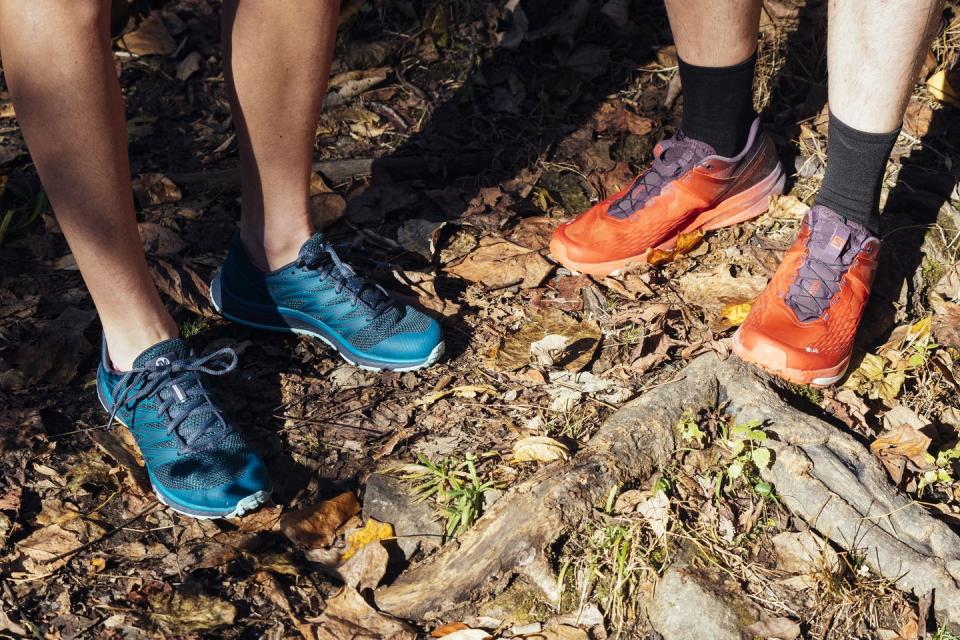
How We Selected The Best Trail Running Shoes
We recommended the best trail running shoes based on a wealth of experience and data gathered by the Runner’s World test team, including down and dirty hands-on testing experience by our editors, data gathered by the Runner’s World wear test group, and additional research provided by our contributors. These shoes deserve special recognition because of their value and overall performance, both on foot and in the lab.
Our Full Trail Running Shoe Reviews
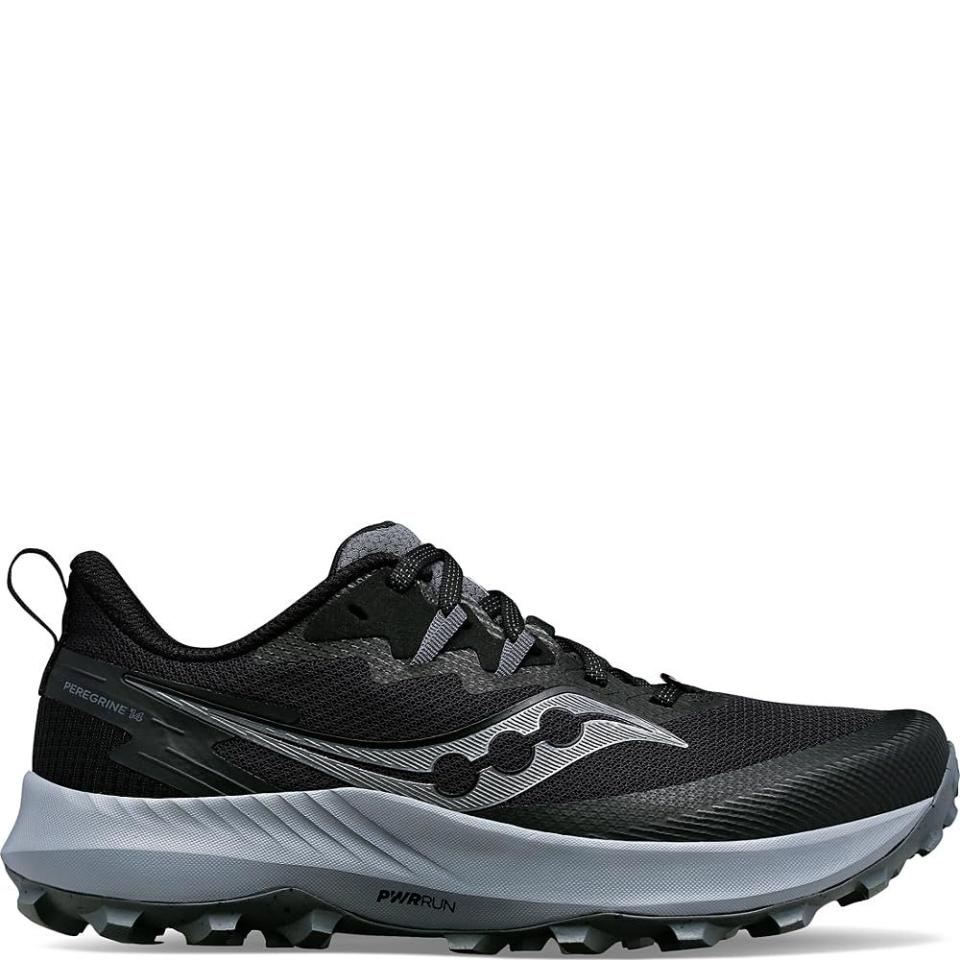
Peregrine 14
amazon.com
$139.95
Saucony’s most popular trail shoe rolls into 2024 with a new Pwrrun+ sockliner that adds cushioning to every step. The EVA-based Pwrrun midsole returns, delivering solid energy return so you aren’t trading pep in your step for grip off-road. We found the v14 builds on the Peregrine’s versatility for longer distances without sacrificing agility or responsiveness.
The new design also has a redesigned mesh upper that adds more padding in the tongue and around the heel collar, which should help you get a snug fit at the ankle without pinching. It weighs a few tenths of an ounce more, but that’s not enough that you’ll really notice.
These updates may feel minor, but that isn’t a bad thing. We’ve long enjoyed the Peregrine’s winning formula, which is just as suited for newbies’ first footprints on a muddy trail as it is for shielding vert-chasers’ toes on rock-strewn singletrack. And, it’s earned multiple awards from our team over the years for its versatility—across terrains, foot shapes, and distances—at a price that doesn’t break the bank.
If you plan to run every day, rain or shine, the Peregrine 14 also comes in a “GTX” variant with a waterproof Gore-Tex lining, which is ideal for keeping your feet dry when the skies open up on your trail adventure.

Moab Flight
amazon.com
$63.54
Over the years, the Merrell Moab has evolved into the most popular and most sold boot in the world, and has spawned several variations. The Moab Flight, a low pared-down version of the original, gives trail runners a taste of the Moab action. A taller drop and stout build preserve some of that “fast hiker” feel, but also make the Flight more accessible to runners coming from high-offset road trainers like the Brooks Ghost or Asics Gel-Kayano.
The Flight uses none of the dense EVA foam found on the original Moab, and instead recruits Merrell’s new FloatPro midsole. The material feels lighter and softer, and relies on its thickness rather than a rock plate to add protection underfoot. It results in a burlier ride, but offers a seriously appealing amount of cush per dollar. (Testers only felt stones poking through the softer midsole on more rugged technical trails.)
If you’re looking for a blazing-fast Merrell, we recommend the new MTL Skyfire 2.

Pegasus Trail 4 GTX
nike.com
$128.97
Thomas HenggeThough the “GTX” distinction suggests ankle-high waterproofness, the material only reaches to the top of the laces. The gaiter collar is instead a stretchy fabric, preferable for shielding against small debris and light drizzle. Not suited for deeper creek diving, this construction does breathe easier. After splashing through shallow riverbeds and rain-filled potholes, no testers reported the soggy wet squish they’d sometimes feel after sealing their feet inside Gore-Tex.
Interestingly, many runners will grab the GTX version for reasons other than waterproofness. The shoe’s outsole uses a different rubber than the non-GTX version. Nike finally made the switch to a stickier rubber. “The shoe performed wonderfully on all surfaces, especially the road,” said one tester, who put more than 120 miles on the shoe, equally split between road and trail surfaces.

Ultraventure 3
$150.00
Thomas Hengge“This isn’t a workout or fast race shoe. This is the long-haul shoe,” one of our wear-tester declared of the Topo Athletic Ultraventure 3. According to one of our wear-testers, shoes with wide toeboxes like the Ultraventure are perfect for ultrarunners. The outsole, made of grippy Vibram rubber, is more lightweight and sectional than that of the previous iteration. Its 3.5mm lugs are shorter and wider as well, making the shoe versatile for both roads and trails.
“The Vibram outsole is sticky enough for rocky trails, but it’s not like a cleat,” said another tester. Even though the shoe doesn’t have a rock plate, the increased stack height—Topo added 5mm to the heel and forefoot—serves as a buffer on rugged terrain. The thicker midsole is composed of a new Zipfoam compound that’s lighter and more responsive than before. (It’s the same bouncy material used in Topo’s Ultraventure Pro model.) To ensure stability, the platform was widened, too.
Still, you’ll want to choose the brand’s MTN Racer or Terraventure, which have toothier treads, if you’re heading down gnarlier trails.

Mafate Speed 4
zappos.com
$184.95
Thomas HenngeThe Speedgoat might be Hoka’s most popular trail shoe, but we think the overhauled Mafate Speed 4 is actually the better pick right now—especially if your trails require comfort and versatility. We found this out firsthand by using the shoe to race up and down Whiteface Mountain.
With a wide range of trail options to pick from, the Mafate was our race day choice as we tackled the Olympic ski hill in New York’s Adirondack Park. It had more than enough bite on black diamond ski trails to let me claw my way uphill, and the cushioning protected my body when I had to dash back down 4,000 vertical feet over just 3.4 miles.
Hoka made a number of key updates to make the Mafate Speed 4 a more runnable and comfortable shoe than its predecessors, including a new two-layer foam setup. The Profly+ midsole puts a lightweight, bouncy foam closest to your foot, which boosts comfort and makes the shoe feel alive when you’re running along hard-packed ground. The bottom layer is durable and firm enough to crush over sizable rocks and protect the bottom of your foot.
When you get into steep or muddy terrain, the shoe still shines. The outsole has been redesigned and there’s more rubber underfoot. Each lug has three distinct tiers, giving you an enormous amount of sharp edges to cling to the ground. Plus, it’s Litebase, to help keep weight in check—Litebase makes the sole thinner and lighter, without diminishing traction.

Catamount 3
amazon.com
$169.95
Brooks debuted the Catamount 3 trail racing shoe in early 2024, building on the success of the previous version’s lightweight and responsive, yet still protective midsole. The key upgrade comes in the form of a new single-layer engineered mesh upper, which delivers a comfortable, sock-like fit, while TPU overlays provide structure to keep your foot secure and protected. It fits a little snugger than Brooks’ road shoes, but that’s a good thing here: A tight wrap will help you avoid rolling an ankle on rocky, uneven terrain.
The Catamount 3’s SkyVault midsole plate enhances proficiency on the uphill, then smooths and stabilizes the ride on your descent, priming it for rolling trails. The plate’s rocker-style shape is curved in the forefoot to help propel you quicker off your toes on the ascents, and doubles as a rock shield.
Testers found that the Catamount 2’s outsole, which returns in the Catamount 3, felt “super grippy” on wet logs and in freezing rain. They dug the energy return from the midsole (also unchanged in the new version), noting that they felt a “pop” on technical trails.
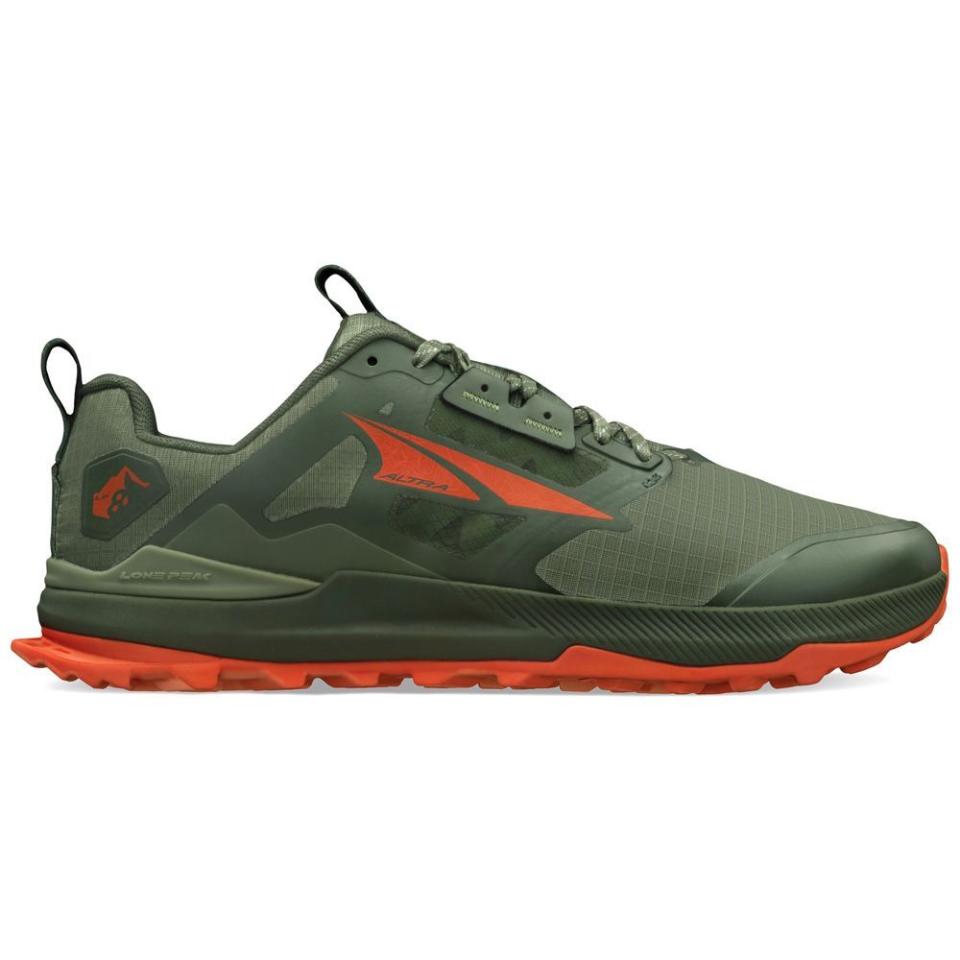
Lone Peak 8
altrarunning.com
$140.00
The Altra Lone Peak gets tougher in 2024. The Lone Peak 8 adds an updated ripstop mesh upper, which includes ghillie lacing for a locked-in, customizable fit. TPU overlays keep your foot planted and protect your toes from impacts. Both of these upgrades should improve the shoe’s durability and performance in technical terrain.
Altra doesn’t have to change much to keep the Lone Peak 8 in the trail shoe pantheon. It already had an award-winning midsole and outsole, both which return in the new design. Altra’s roomy, anatomical foot shape allows your toes to splay naturally. (It’s tough to really grasp how much your trail shoes may be jamming your toes together until you experience a natural fit like this.)
Altra’s signature zero-drop design keeps 25mm of cushioning beneath your foot in the front and back of the shoe, which takes some getting used to. Tread carefully if you’re coming from a 10mm drop shoe, which requires less flexibility in your foot and ankle. If you dig the wide shape and zero-drop design, though, you’ll be rewarded by immense traction and comfort.
“The route I run most is a 4-mile loop on a mountain that has every kind of surface that one can expect to get in Pennsylvania—gravel, technical downhills, rocky climbs, and water crossings,” said one tester who put more than 150 miles on the previous version of the shoe. “This shoe grips all of it. The traction is fantastic, and the cushioning is ample, but still allows for ground feel and solid footing on rock.”
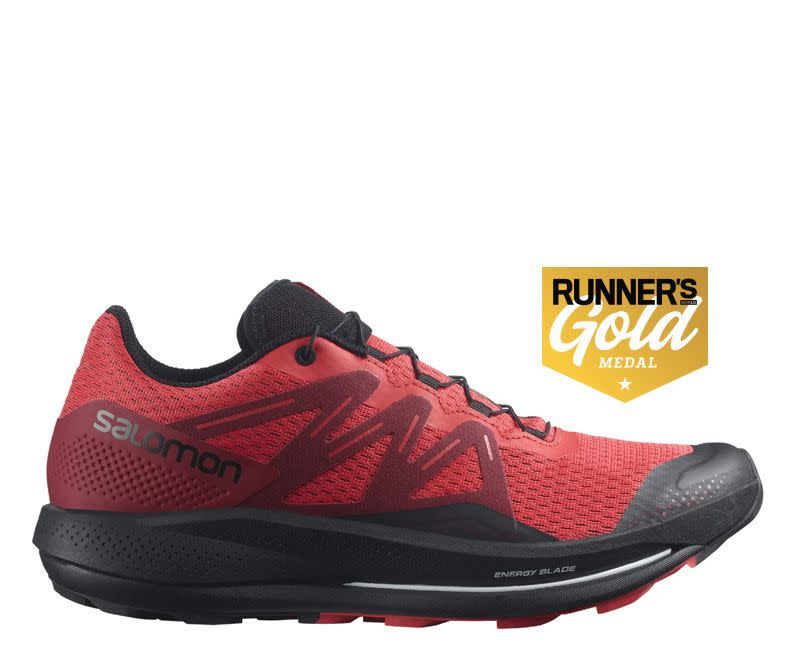
Pulsar Trail
$105.00
Salomon’s Sense Ride has been a cult favorite among both beginners and longtime trail racers. Its firm, durable cushioning handles daily jogs and long runs comfortably, and the moderate heel-toe offset feels accessible to low-drop and high-drop runners alike. The Pulsar Trail has similar traits, but adds an energy-return boosting perk—a propulsive TPU plate that Salomon calls “Energy Blade”—for just a $10 price bump.
Testers said the Pulsar feels slightly softer and more responsive than the Sense Ride, and praised its reliable traction and secure inner fit sleeve. “The cushioning is protective and bouncy, but not super plush. I didn’t feel sharp rocks underfoot and my turnover still felt fast,” said one tester who logs about 50 miles of road-to-trail running per week. “There’s a slick and mossy flat rock on the Warren Highlands trail that I test every trail shoe on. I’ve bit the dirt many times on it, but not while wearing the Pulsar. I felt super confident bombing down the descent.”

Trailfly G 270 v2
$170.00
With the original Trailfly G 270 (first released as the TerraUltra G 270), Inov8 debuted a new iteration of its Powerflow foam. The cushioning incorporates more TPU in the mix, which feels more forgiving while returning more energy to your stride.
Sitting on top of that midsole is a fresh footbed to match. (Made from tiny compressed TPU beads, it’s more responsive than a regular foam or gel insole.) Together, these two elements combine for a ride that feels like a firm Salomon with some subtle bouncy Adidas Boost undertones—without losing good connection to the trail.
That energetic midsole returns in version 2.0. In this update, Inov8 focused on the upper, improving the overall stretch and breathability of the material to let your pinky toes splay and breathe easier. Testers told us the additional padding around the ankle collar also feels softer and locks down the heel more securely.
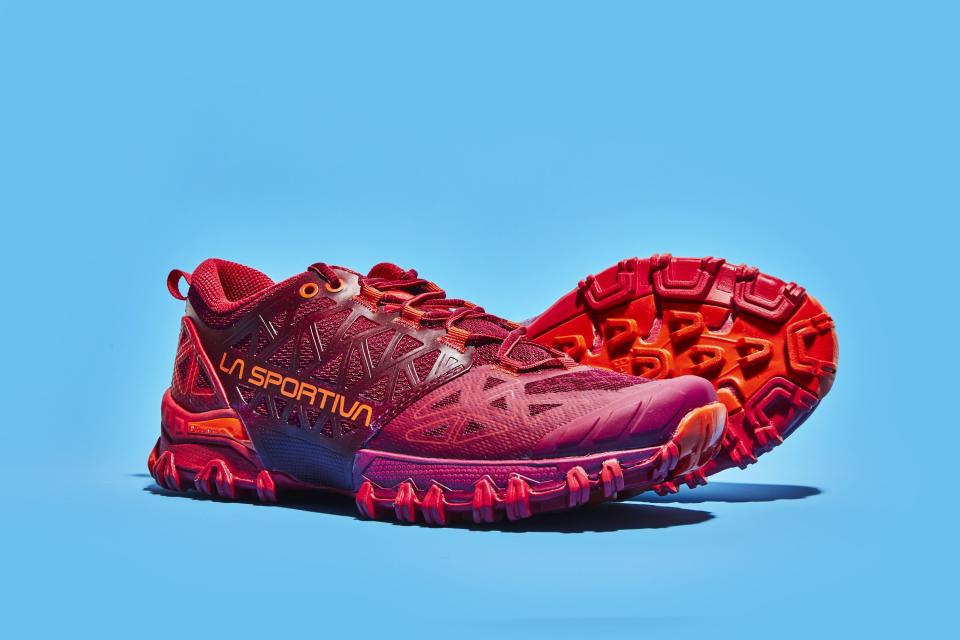
Bushido II
rei.com
$99.93
Trevor RaabThe Bushido has been around for awhile, but it continues to earn a spot on this list. Why? This burly trail crusher brings plenty of structure and support to a responsive platform. But the outsole is what we like most—sticky, aggressive lugs line the perimeter and bottom of the shoe, making it easy to virtually grab hold of uneven terrain.
We also appreciated the heavy-duty toe cap, which protects the foot should you kick into rocks. A breathable mesh upper and just the right amount of cushion in the midsole make this standout shoe versatile enough to manage long, slow mileage as well as speed workouts.
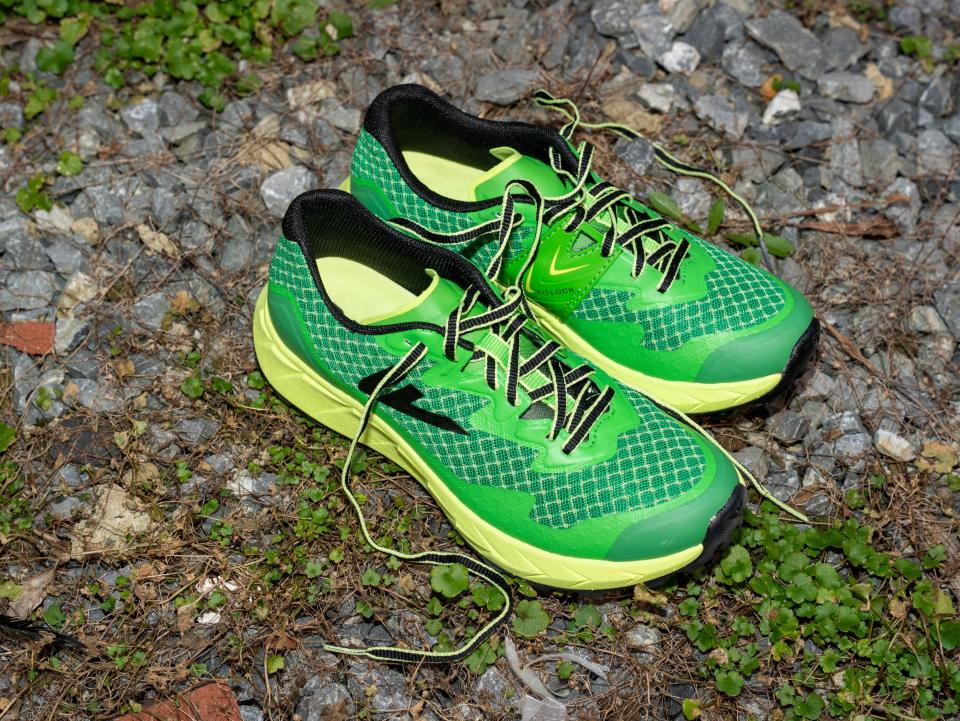
Ultra 2
amazon.com
$170.00
Thomas HenngeWhile many VJ shoes, including the Maxx and the XTRM, are designed for obstacle course racing and trail running, the Ultra is specifically designed for long-distance. It adds more cushioning underfoot, which feels lightweight yet ample for spending hours to days on the trail.
The best part of VJ shoes is still the traction, though, and the Ultra lives up to the brand’s slogan, “#BestGripOnThePlanet.” The butyl-rubber outsole is studded with 4mm, chevron-shaped lugs, which give the Ultra a tacky hold on wet, jagged surfaces.
“The traction this shoe had in all conditions was insane,” said one tester. “I ran these shoes through everything from bone-dry trails to monsoon summer rainstorms and was blown away—definitely the most grip I’ve had on a trail shoe, hands down. On short road stretches, the feeling is like walking across a dirty dive bar floor on a hot summer day—sticky.”
Q+A With Our Experts
What makes a great trail shoe?
It depends on the trails and the runner, but you generally want to see thicker and softer outsole rubber than you find on a road shoe. The midsole may be made of a similar material, but it should include a rock plate (a plastic plate embedded in the foam) if your trails include sharp rocks and stones.
For the upper, fit and protection are critical—you don’t want to roll an ankle as the shoe rotates about your foot, or break a toe from accidentally kicking a boulder. To prevent those misfortunes, trail shoes come with reinforced uppers in the form of TPU overlays at the midfoot and toe box.
Do I need my trail shoe to be waterproof?
Some trail shoes have lining made from Gore-Tex or a similarly waterproof material to keep your dry on wet trails. That sounds like a big benefit at a glance, but the reality is a little more complicated.
There are pros and cons to wearing waterproof running shoes. On the plus side, your feet will stay dry for longer when you're running through a rainstorm, which can help you avoid soggy feet and blisters.
That said, even the most waterproof trail shoes will eventually get saturated in a downpour, and they don’t tend to drain as well once they do get wet. Also, waterproof membranes that keep moisture out will also lock moisture in: That keeps sweat vapor from escaping your shoes.
No matter your approach, your running socks are key for moisture management: Thin, synthetic materials dry out quicker and don’t hold as much water, meaning less added weight on your feet.
What is shoe “drop?”
If you’ve read shoe guides from Runner’s World before, you may have noticed that we always highlight the “drop” of every shoe we recommend. Drop, or heel-toe offset, is the difference between the amount of material beneath your heel and your forefoot. For example, a shoe with 10mm of drop might have 25mm of foam and rubber beneath your heel and 15mm beneath your forefoot.
Your feet may agree with a variety of drop measurements, but shoes with less drop require more flexibility in your foot and ankle. If you’re used to a 10mm drop shoe on the road and choose a zero-drop shoe for the trails, be aware that your lower legs will be working harder until your feet adapt. That could pay dividends in the long haul as your feet and ankles get stronger and more flexible, but be wary of rushing the adjustment period.
You Might Also Like

